This was published 1 year ago
‘Loads and loads of people got injured, some died’: Why holidays and risk-taking go hand in hand
By Tim Barlass
Sometimes travel is a test of our wits, our nerve, our endurance, or all of the above, and it can take us far beyond our comfort zone.
That’s the message on the website of a travel insurance company specialising in providing cover for all, well, almost all, of the crazy things we think might be a good idea to try on holiday. Being on our hols seems excuse enough to do all sort of things, like trekking on White Island Volcano in New Zealand, mountain biking down the “Road of Death” in Bolivia or crossing a crocodile-infested river on foot.
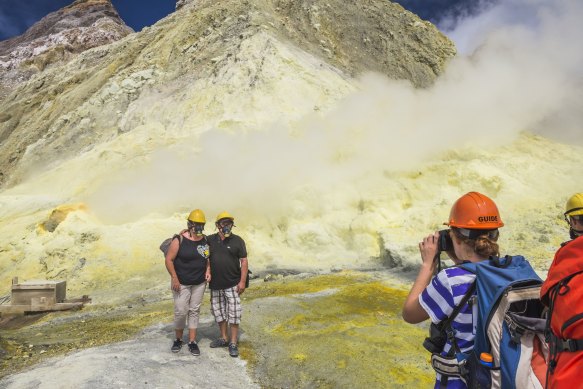
Tourists on a sightseeing tour of White Island Volcano, an active volcano in the Bay of Plenty, North Island, New Zealand that killed 22 people, including 14 Australians, when it erupted in 2019.Credit: Getty
Add to the mix the vagaries of the weather and the uncertain nature of the quality or maintenance of the equipment upon which you will be reliant, and you could be in for more of a white-knuckle ride than you bargained for.
Such things were thrown into focus by the events of last week in what was supposed to be a mates’ trip of a lifetime, celebrating a 30th birthday on a remote, private island in Indonesia. Instead, for four Australians and their boat’s crew, it turned into a fight for survival.
After spending 36 hours floating at sea on surfboards off the coast of Indonesia’s Aceh province, Elliot Foote, his partner Steph Weisse, and their friends Jordan Short and Will Teagle, were found by rescue crews on Tuesday. The search continues for one remaining missing member of the three-person crew, Indonesian man Fivan Satria.
The full details of what went wrong may emerge with time but what has been stated is that the wooden longboat they were travelling in began to take in water in a storm.
There are inherent risks with water activities where the weather, tides currents and local – perhaps unknown – factors are all part of the safety equation. But there is little doubt that, as the young – and the not-so young – seek out new travel challenges, thrills and experiences, the chances of something going wrong are heightened.
Ben Groundwater, a travel writer for the Herald, has observed the risk-takers at play and taken a few himself. In Laos, in the town of Vang Vieng, he experienced the river activity of “tubing”.
“What you did was you jumped in an inner tube at the top of the river and floated down and people had set up all these bars aside the river so you would just float in, have a few drinks then continue on floating,” he said. “It started off as being a pure and beautiful experience, but after a while people just kept pushing the limits and getting crazier and crazier and drunker and drunker. They set up waterslides that shot people into the river and swings that took them out over the river and there were signs warning about rocks in shallow water.
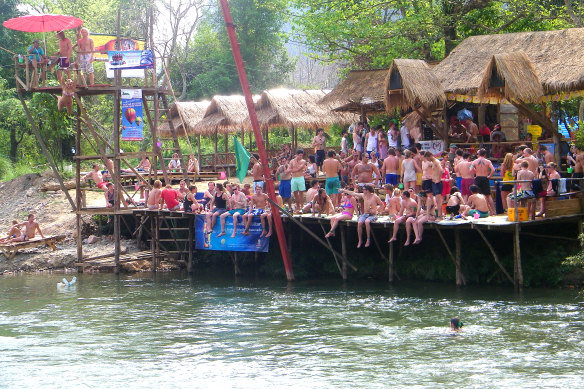
Australian tourists wait to go tubing in Vang Vieng in Laos, 2012.
“Loads and loads of people got injured, some died because of how drunk they were getting and the risks that they were taking that were in no way regulated. When you come from Australia you have a trust that with anything you can do, someone has checked that it is OK. But that’s not the case in some parts of the world.
“I, personally, drank quite a lot and went on a swing and didn’t hang on to it properly and slipped and fell into shallow water – but not so shallow that I actually got injured. Obviously, access to medical treatment and help in those sorts of areas is really limited compared to home.
“I considered myself very lucky and very foolhardy. You take these risks thinking that everything will be fine, being swept up in the joy and adrenaline of being on holiday somewhere new, where it feels like the rules don’t apply, and you find out sometimes that they really do.”
He added: “There’s also the people factor, and I don’t want to suggest the people in Indonesia did anything wrong or acted in an inappropriate way, but in my personal experience you don’t actually know the person that you are putting your safety in the hands of.”
Of another experience, he added: “I went mountain biking in Colombia, and I’m not particularly experienced as a mountain biker, but you don’t actually know what the bike is like or anything about the company. They took us up to the top of this hill and said: ‘There you go, cycle down to the bottom.’ It was hairy. I was scared a lot of the time, it was steep, slippery, there were bare rocks that you had to go over and huge tree roots you had to cross at speed, and it made me realise, OK, I’m not actually skilled enough to do this. But no one checks, no one worries about that. If you are happy to do it, they are happy to facilitate it for you.”
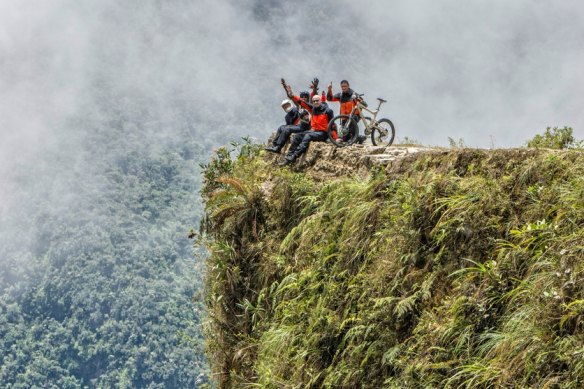
The only way is down: mountain bikers at a viewpoint of the famous downhill trail “Road of death” in Bolivia.Credit: iStock
So what is it that makes us turn off our inbuilt caution mode when we are away on holiday? Dr Catriona Davis-McCabe, the president of the Australian Psychological Society, says relaxation with the change of routine is a factor.
“I think people are more relaxed when they are away from everyday life and their day-to-day stresses, and we know when they are away on holiday, anxiety is often lower. When anxiety is lower, we might be tempted to try things we usually wouldn’t.
“When we are away, we have less accountability, and we are there to have a good time and wanting to make memories and that might mean something that might involve risk. I also think that travel improves self-esteem and confidence and when we feel more confident, we might feel the urge to be brave, to try something new or that other people are doing. Perhaps people are not really thinking ahead, they are more involved with being part of the group than thinking through the consequences of what might happen.”
Dr Garth Lean, a lecturer in tourism at Western Sydney University, said that peer pressure in a group and the need to experiment were both factors in risk-taking.
“There’s a theory in tourism around travel being a performance and putting on a mask and when you leave home, you go out, and you experiment with the world and explore in its permission to try different things in this space of play,” he said.
“It is rather like children: they use play as a form of experimentation to learn about the world, about their limits and to try new roles and behaviours. Travel and tourism provides that for adults.
“I don’t think we are judged as much [travelling] as if you were at home. People say, “Oh, they’re travelling; that’s what you do when you travel, right? When you leave the home space you don’t have the same observation and control over your behaviours from loved ones, you are away from those safety nets.
“The longer you travel, the more you get into this behaviour, you meet other people who provide a different environment that enables those behaviours.
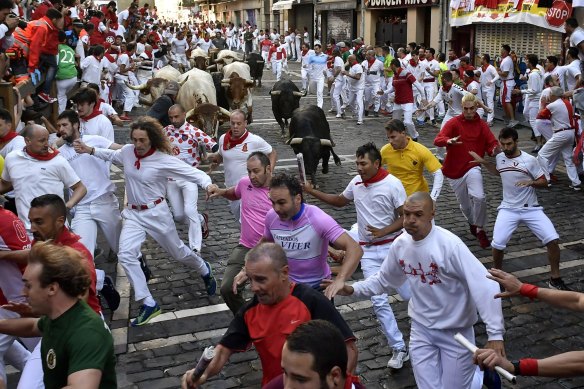
Running of the bulls in Pamplona, Spain in 2019. Good for tourism ... maybe less so for tourists.Credit: AP
“I think social media encourages those particular behaviours. There’s a whole phenomenon of people taking their kit off when they travel, taking pictures in Indonesia and Bali at sacred sites or on the top of mountains, that’s all about encouraging those risk-taking behaviours.”
A Department of Foreign Affairs and Trade spokesperson said Smartraveller provided advice to Australians travelling overseas for extreme sports and adventure activities to assist in managing their safety and security abroad.
“The risk an adventure activity poses often depends on the country you are in and their regulations,” the spokesperson said. “Travellers should choose reputable licensed providers and check the equipment and safety gear they will be using. Don’t use it if it doesn’t look, feel, or sound right.”
Most travel insurance policies will only include adventure activities if you pay extra to be covered. When you buy travel insurance, the advice from the industry is to choose a policy that covers your planned activities and read the product disclosure statement in detail, including the activity definition table. How activities are defined by insurance providers is often different from what you would expect. Don’t assume that because a policy covers one activity, a similar or related activity is also covered.
The CHOICE Travel insurance buying guide also provides tips for travellers about how to choose the best insurance to cover their overseas plans.
World Nomads travel insurance categorises activities into grades 1, 2 (higher risk) and 3 (highest risk). Ballet and a camel ride are category 1, pay a bit more on your premium for elephant trekking and more again to compete in the Tough Mudder endurance race. If you are planning running with the bulls in Pamplona then your search for travel insurance may be a long one.
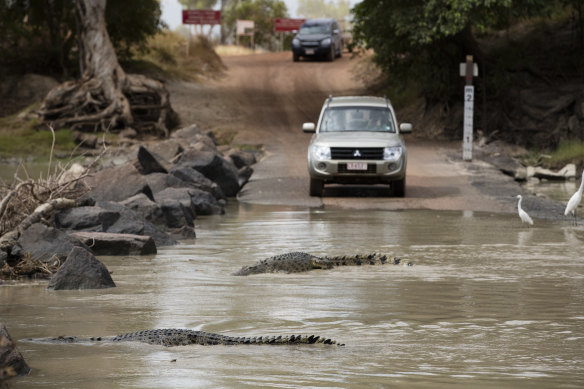
Safe to cross? East Alligator River where Kakadu National Park and Arnhem Land meet.Credit: Glenn Campbell
You don’t have to go outside Australia to take risks, as Herald travel writer Andrew Bain is proof. “In the year 2000, I cycled around Australia. We got to one of the rivers in the Kimberley, very wide and we knew the potential for crocs in it so we waited to get a lift across in a four-wheel drive hoping someone would turn up, but no one did.
“We got impatient, and we pushed our bikes across the river, it was probably about 100 metres wide. We had full panniers on the bikes and they started to float away because the river was high enough. We were scrambling around to get the bags. We didn’t see a croc but we did learn that a dog had been taken at that spot within a couple of weeks of us being there.
“I’d never seen a saltwater crocodile. A few weeks later, I arrived in Darwin and saw this six-metre croc, stuffed in the museum. My heart just about stopped.”